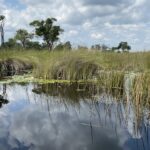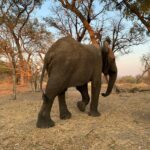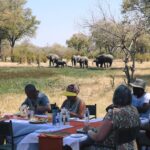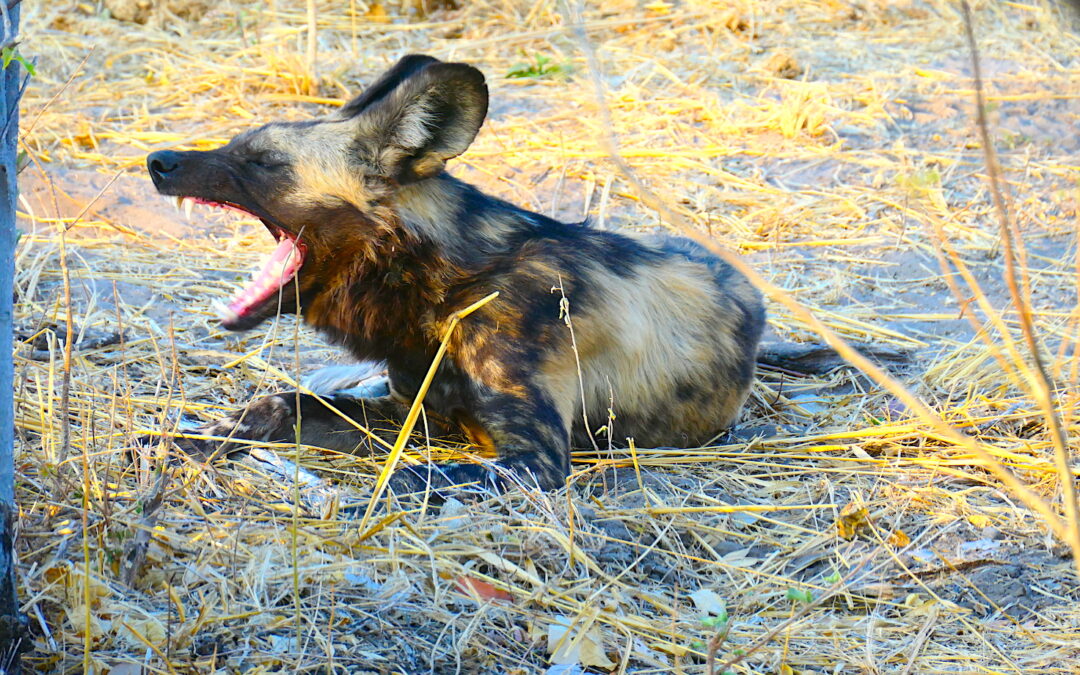
Nov 2, 2019 | Adventure Safari, Animals of Botswana, Brave Africa Safari, Game Drive
On a safari in Botswana in Brave Africa, there’s always something new to experience. We never know what we’re going to see on a game drive, but we know it’s always going to be something exciting as long as we’re open to the possibilities. This time it was a pack of wild dogs hunting.
On our most recent trip out to Xakanaxa (Moremi Game Reserve), even our staff got to join in on the excitement when at least two-dozen wild dogs, including four puppies, hunted an impala at camp.
Wild Dogs at Camp
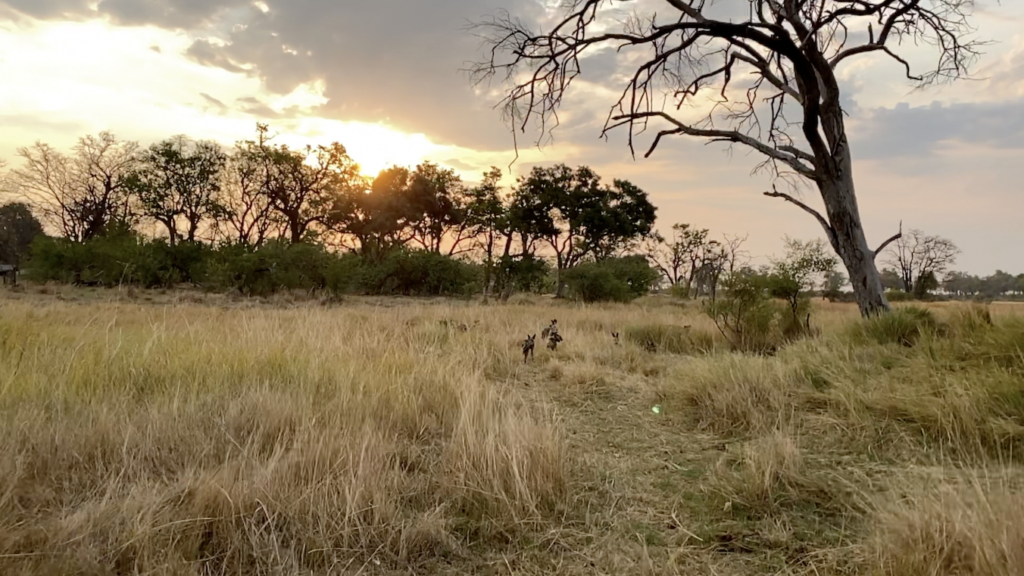
Wild dog pack of about two-dozen dogs hanging out at the Brave Africa camp in the Moremi Game Reserve.
After a wonderful all-day game drive, Wina and our guests were heading back to camp for dinner when they ran right into a huge pack of wild dogs. We were barely a hundred meters from camp. You could see the staff tents, our moving trucks, and the main tent, and yet right there in front of us, there had to be about two dozen wild dogs all walking along in the setting sun, including four puppies—around six months old.
They had just woken up from their afternoon nap and were on the hunt.
With a pack that large—more than twenty dogs—hunting enough food for everyone is a challenge. The pack has to kill multiple times a day to stay healthy, and that can be especially difficult with pups. The pups always have to be protected, but they also have to learn how to hunt, so it’s a fascinating balancing act.
When we first came upon them, the pack was slowly meandering along. They were spread out and looking for food, but nothing urgent. The pups were toward the back, bouncing along, with assigned minders to make sure they kept up and didn’t get into too much trouble. And the rest of the pack was in formation, looking for prey.
Then, between one moment and the next, everything changed.
Wild Dogs Hunt at Brave Africa
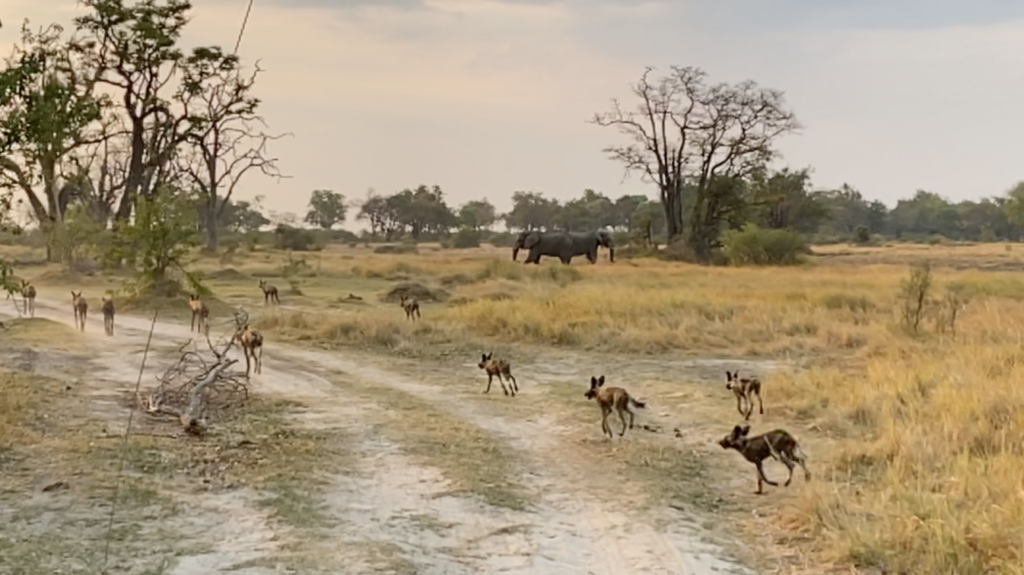
The wild dog pack prepares to hunt.
Suddenly, we heard some high-pitched squeaking. It was the dogs sending out a warning call about nearby prey. It seemed like we blinked, and then there was an impala on the move.
She was in the wrong place, at the wrong time. No lone animal would stand a chance surrounded by more than 20 hungry dogs, and neither did she. While she leaped and ran as fast as she could, she wasn’t fast enough.
The wild dogs won.
Only a few of the pack actually went to the kill site, the rest stayed back with the puppies, and so did we. The puppies didn’t have the energy to keep up with the adults on the hunt, and we didn’t have the speed, but in this case, waiting behind was not a problem.
While we didn’t witness the kill, a few minutes later, we saw something just as special.
Wild Dogs Taking Care of Puppies
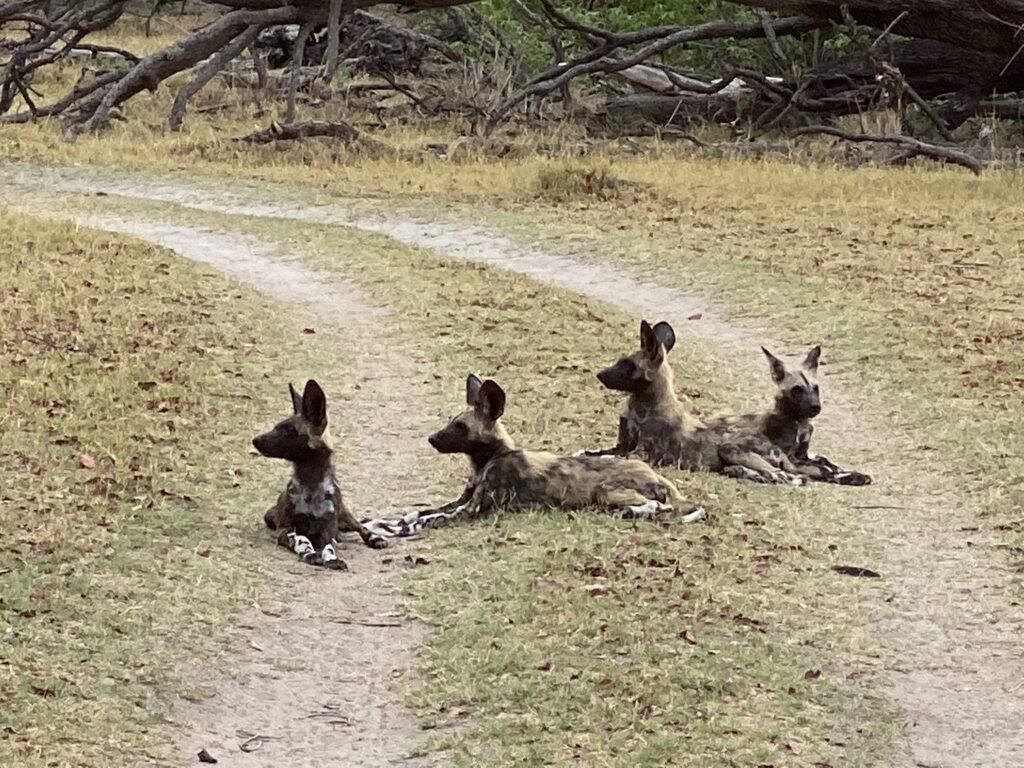
Four wild dog puppies waiting for the adults to come pack with food.
Wild dogs are incredibly social creatures. They are all about the pack. No dog is left behind, and every pup is well cared for, and we got to witness this first-hand.
Since the puppies were too young to hunt, the adults brought the kill to them. No, they didn’t drag over the kill like lions would do. They also didn’t force the puppies to move to the kill site—that would be too dangerous. Instead, the adults took turns eating and regurgitating food for the puppies.
That’s right. We got to witness wild dogs vomiting pre-chewed and swallowed food so the puppies could enjoy.
It was ADORABLE. And no, we’re not joking.

Wild dog puppies eating regurgitated impala thanks to a successful hunt.
It was astonishing to see the family dynamics. The four puppies stayed together, and every time an adult came back from the kill site, they immediately went up to the puppies and regurgitated enough for a meal.
The puppies squeaked and squealed and ate their dinner happily until the next adult would come back. They did this over and over again until the puppies were full, and the kill was demolished.
Wild Dogs and Brave Africa Staff
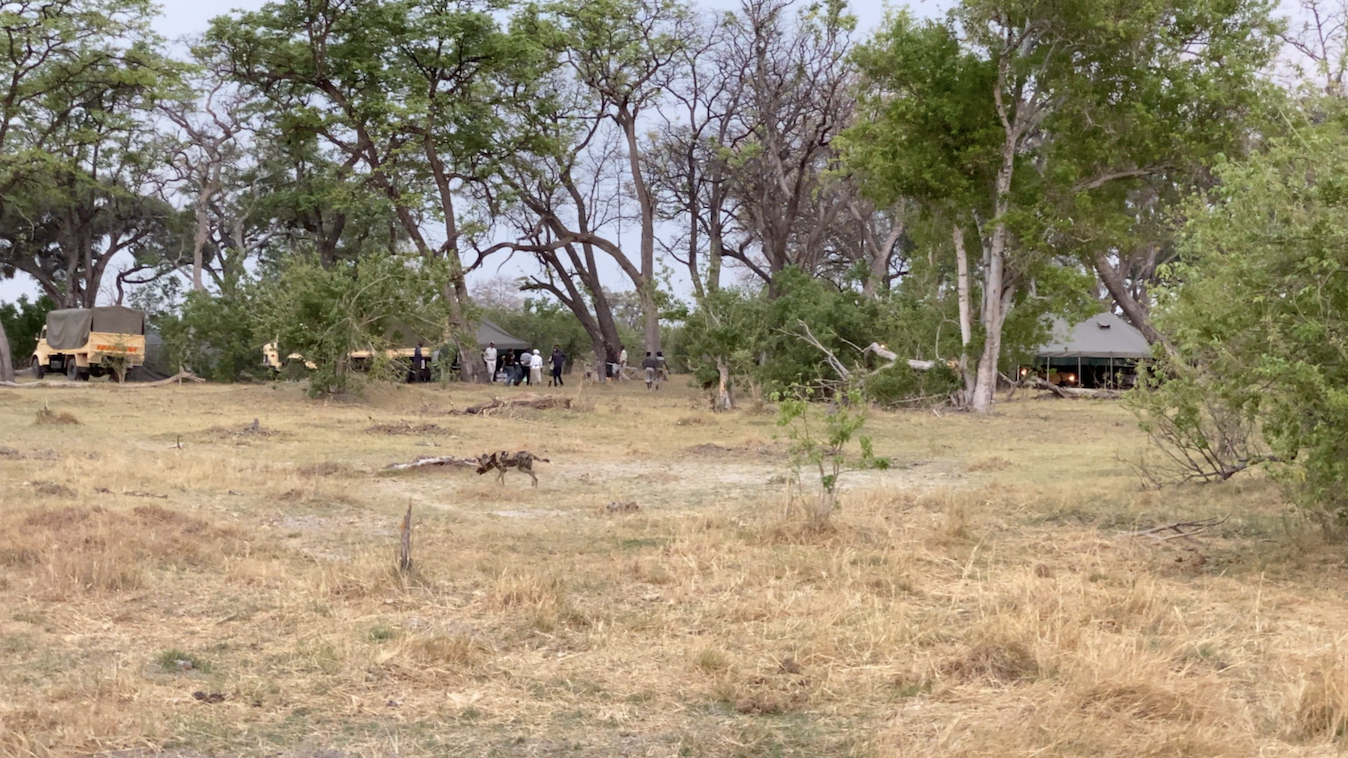
All the Brave Africa staff came out to watch the wild dogs hunt. You can see our main “mess” tent on the far right with our staff tents and moving vehicles on the left.
For some of our Brave Africa staff, it was the first time they’d ever seen a pack of wild dogs. While they’re out in the bush regularly, they mostly stay at camp. This means they’ve all seen elephants and various antelope, but predators are always rare, and they’re especially rare if you remain at camp and don’t go looking for them.
This time, the staff didn’t have to go on a game drive to experience something that is incredibly rare and exciting. All they had to do is stand at the edge of camp and watch. It was thrilling, and something we’ll be talking about for years.
Watch the wild dogs hunt for yourself!
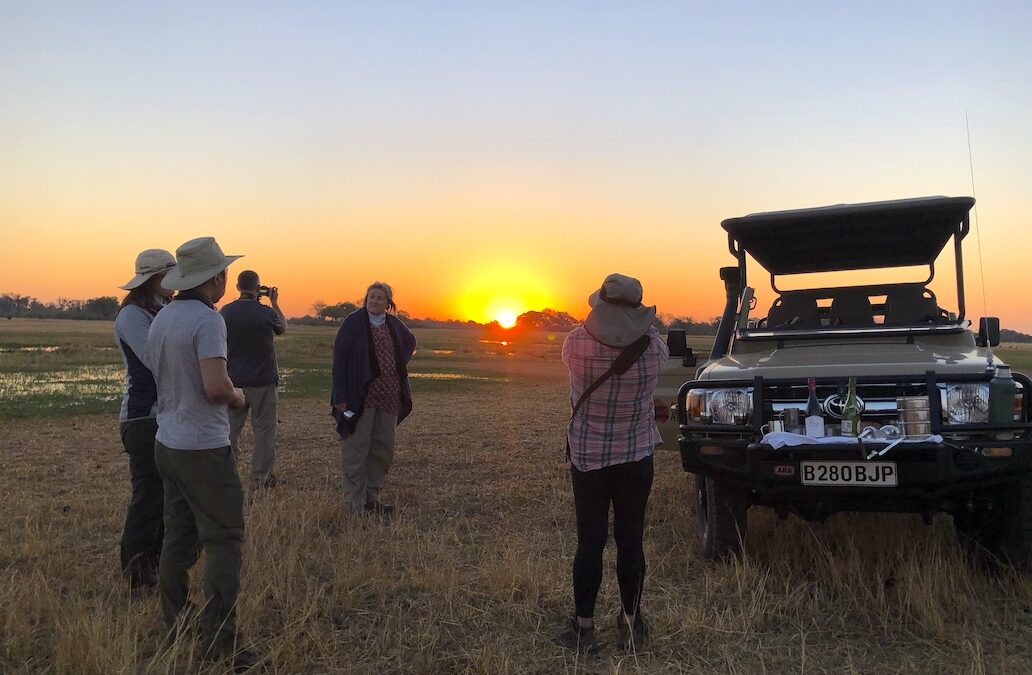
Oct 19, 2019 | Adventure Safari, Brave Africa Safari, Conservation, Most Popular Blogs
Before you decide where to go on your African safari, check out our ten reasons to go on safari in Botswana. We know you’ll love the Okavango Delta, Kalahari Desert, and Chobe National Park. Because if you’re looking for a safari that offers:
- 130,000 elephants
- Fewer crowds
- Conservation-focused tourism
- Incredible scenery
- 3,000 lions
- An adventurous experience
- Remote locations
- LGBTQ+ friendly policies
- Friendly people
- The best safari location in Africa
Look no further than Botswana! It’s truly a one-of-a-kind destination that everyone should experience.
1. 130,000 Elephants – The most of any African country
Botswana is known as “The Land of the Giants.” The country boasts 130,000 elephants, almost double the number of elephants you’ll find anywhere else in the world. This makes Botswana a haven and last refuge for these majestic creatures for the last 15 years.
What this means is that when you go on safari in Botswana, you’re almost guaranteed to see elephants every single day, multiple times a day. In fact, on our most recent trip out, we rarely had lunch without a few elephants stopping at a nearby watering hole to drink while we ate. Elephants roamed near our camp, came directly up to our safari car, and were almost everywhere we looked.
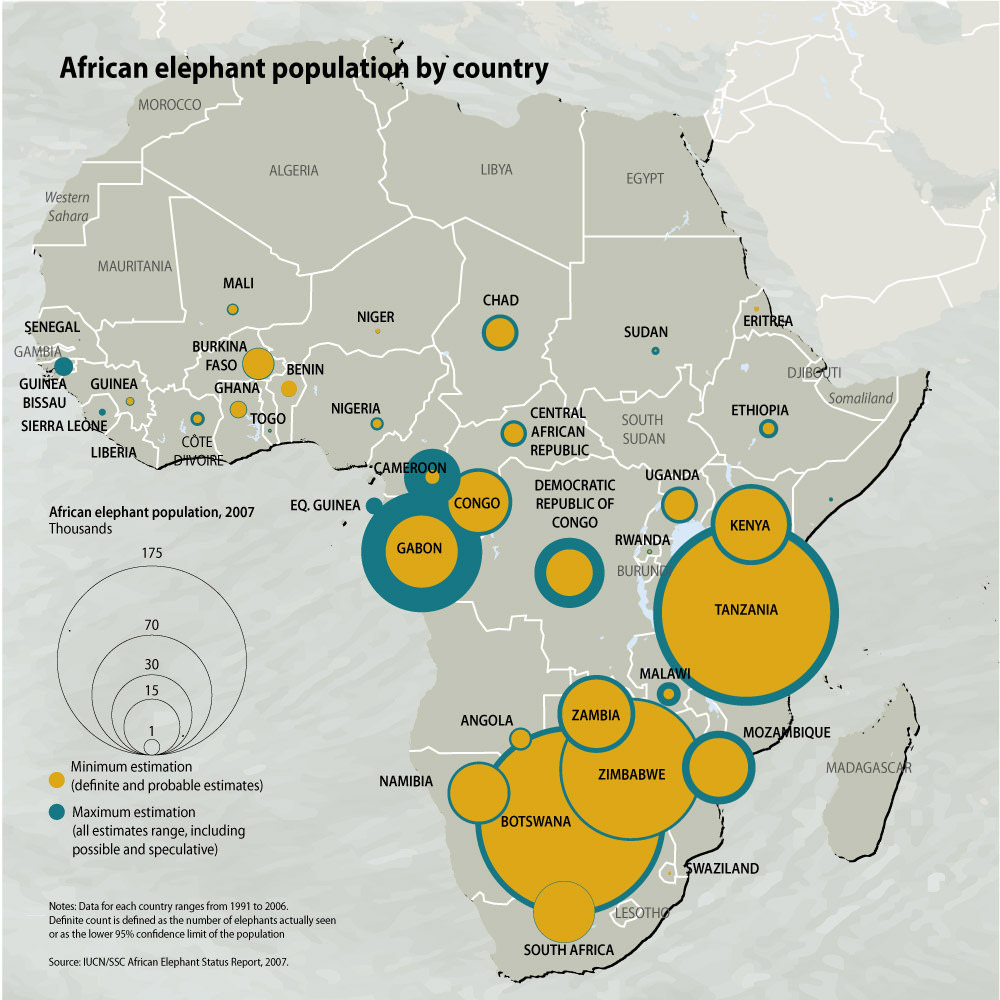
Botswana has the highest concentration of elephants by far.
2. Fewer Crowds — The experience is focused on quality, not quantity
The last thing you want when you go on safari is to be surrounded by crowds of people. After all, you’re heading to Africa to see the wildlife, not more tourists.
Botswana is considered the “road less traveled.” Fewer people think about Botswana when they consider locations for their African safari, and so there are far fewer tourists. For example, in Kenya’s Masai Mara, there are 7,000 beds available for tourists. In Botswana’s Linyanti Reserve (just outside of Savuti), there are only 58 beds in the same size area.
Botswana also has legislation in place that limits the number of tourists that can be in any single area. You won’t find as many tourists on safari in Botswana’s Okavango Delta, Chobe National Park, or the Kalahari Desert, and the camps are kept small. Most camps, including Brave Africa, max out at six tents, 12 guests. We also max out our safari vehicles at just six guests, so that every row has only two people and no middle seat.
The idea of Botswana is to have fewer crowds and more animal encounters. And isn’t that what you want?
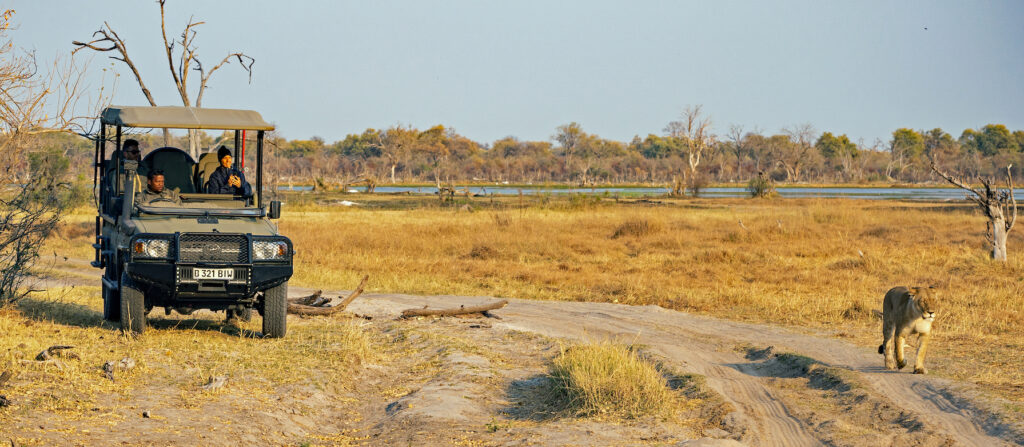
3. Conservation Focused — Botswana is ranked #1 in the world for conservation
Botswana is considered one of the last sanctuaries in Africa with untouched wilderness, making it a haven for endangered species. More than 25% of Botswana’s land area has been set aside for parks and reserves, dedicated to protecting the stunning landscapes and wildlife.
In 2017, the Lonely Planet ranked Botswana the #1 country in the world for conservation, saying, “they keep visitor numbers deliberately lower than they could so that they can manage the environmental impact of wilderness tours.”
For example, let’s take a look at rhinos. In 2001, Botswana had no rhinos left, so the country passed serious legislation focused on combatting poachers and protecting wildlife. Poaching in Botswana was punishable by death for a few years, and they are the only country to deploy the national military to keep poachers out. Today, around 400 rhinos have been reintroduced to the Okavango Delta.
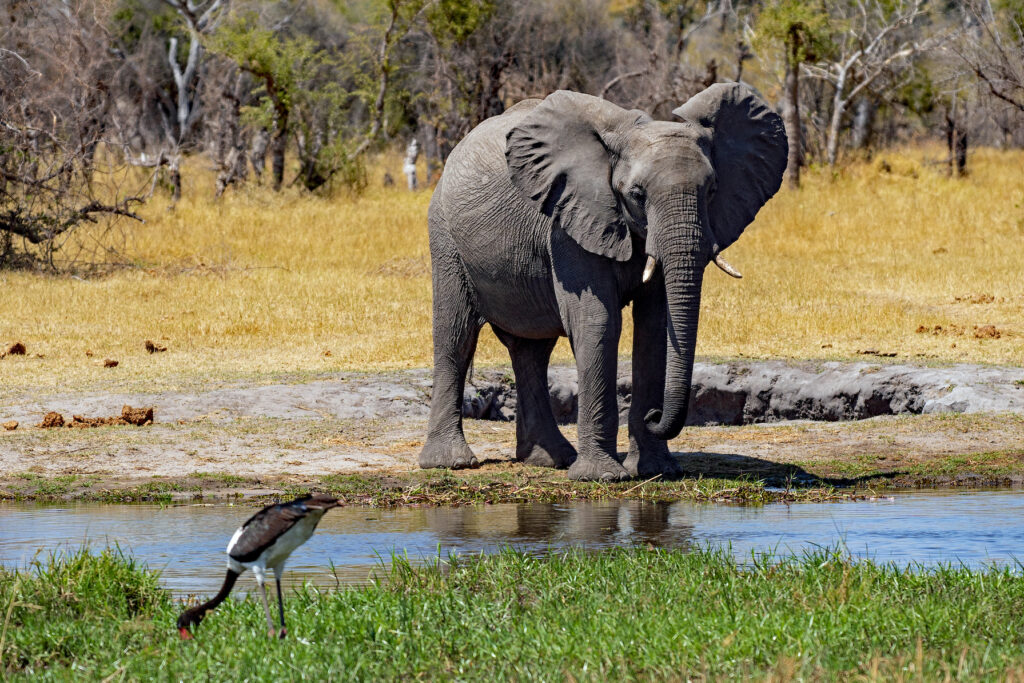
4. Incredible Scenery — Varied and stunning landscapes in the Okavango Delta, Kalahari Desert, and Chobe
Botswana is home to some of the most pristine and stunning landscapes in all of Africa. You can find a little bit of everything in the country from dusty red deserts to lush swamplands, sweeping floodplains, expansive savannahs, and vibrant forests. Honestly, during one all-day game drive, you can travel through a complete range of raw, rugged, and stunning landscapes.
In particular, the magical Okavango Delta stands out as Botswana’s main draw. It’s 16,000- square kilometers of wilderness with some of the densest wildlife in the world. The area is considered one of the largest inland water systems on the planet and home to one of Africa’s most diverse and vibrant ecosystems.
It’s a dazzling area with an abundance of lions, wild dogs, leopards, hippos, elephants, giraffe, kudu, and more. Then, there’s the Kalahari Desert that extends 900,000 square kilometers and covers much of Botswana. A semi-desert, it offers vast tracts of land that are excellent for grazing after good rains. This area is home to black-manned lions, oryx gazelle, and the incredible flamingo migration in Makagadikgadi Pans.
5. 3,000 Lions — Second only to Tanzania in lion populations
Lions can also be found throughout Botswana. In fact, after Tanzania, Botswana claims the largest population of lions in Africa. They thrive throughout the Okavango Delta, Central Kalahari, and Savuti. Best yet, lions in Botswana have some unique distinctions.
The Kalahari Desert is the only place in the world where you can see black-manned lions. These lions are known for their massive size and beautiful manes. Beyond their stunning manes, they also tend to have higher levels of testosterone, a better chance of survival, and a healthier disposition.
Then, in Savuti, there’s a pride of lions known as elephant killers. This incredible pride has learned how to take down adult elephants. While it’s not something you particularly want to witness, it makes the Savuti lions stand out for their unique hunting habits.
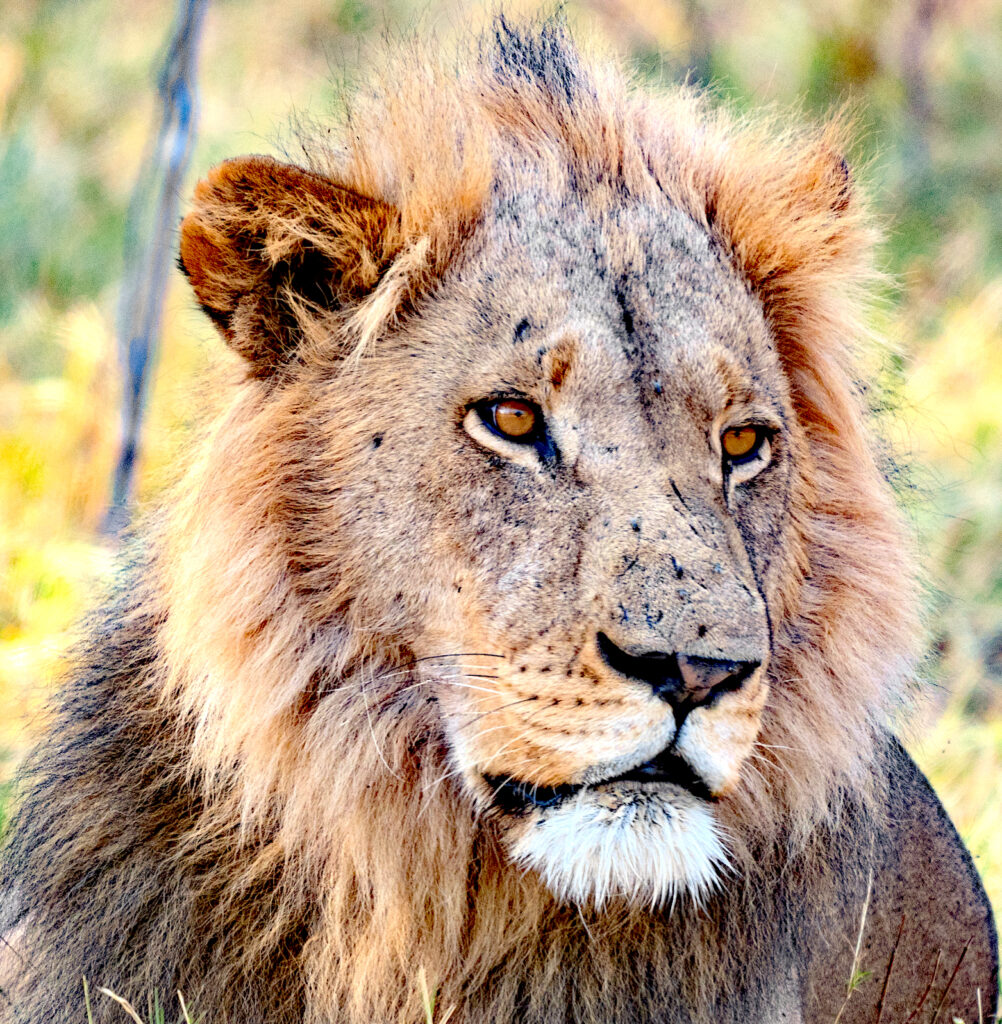
6. Adventurous Experience — Harkens back to the original safari experience
Since there are fewer tourists in Botswana, it creates a more intimate safari experience. It also translates into a much more adventurous safari that harkens back to the old days when Africa was relatively untouched by the rest of the world.
When you go on Safari in South Africa, Kenya, or Tanzania, you’ll notice that the animals tend to be very tame. Just search for videos on YouTube of cheetahs jumping on cars or a herd of zebra walking right near a car. There are so many tourists funneled through these destinations every year that the animals are desensitized. You might as well be at a zoo for all the attention the wildlife will pay to you.
That’s not the case in Botswana. Many animals in Botswana’s Okavango Delta and Kalahari Desert are still skittish around cars and people, which makes for a very different experience. It truly feels like you’re in the middle of the African Bush searching for incredible animals. Every day is an adventure, wondering what you’ll find and encounter. And because the animals are less used to humans, you always feel privileged when you have a fantastic sighting.
For example, we ran into a cheetah on our last time out that clearly did not recognize the sound of vehicles. As soon as it heard our engine, it took the cautious approach and disappeared. And while it was disappointing not to have more time with the cheetah, it was incredible to think that we may have been some of the first people to ever see him.
When you go on safari in Botswana, you feel more like an explorer, braving uncharted territory. And you feel grateful and proud of every perfect picture captured, and experience enjoyed.

7. Remote Safari Destinations — Bush planes are required to go on safari in Botswana
Part of the adventure experience in Botswana is getting to your camp. While you’ll drive most places in South Africa, Kenya, and Tanzania, Botswana requires bush planes. The Okavango Delta is massive and can swell to three times its permanent size in the rainy season. This means that driving to your remote camp isn’t feasible. Instead, you have to fly into dirt airstrips.
We think this remoteness is what makes Botswana so incredible. There are no roads near your camp, just dirt paths. A Botswana safari is truly an exclusive and immersive experience where it’s all about the wilderness.
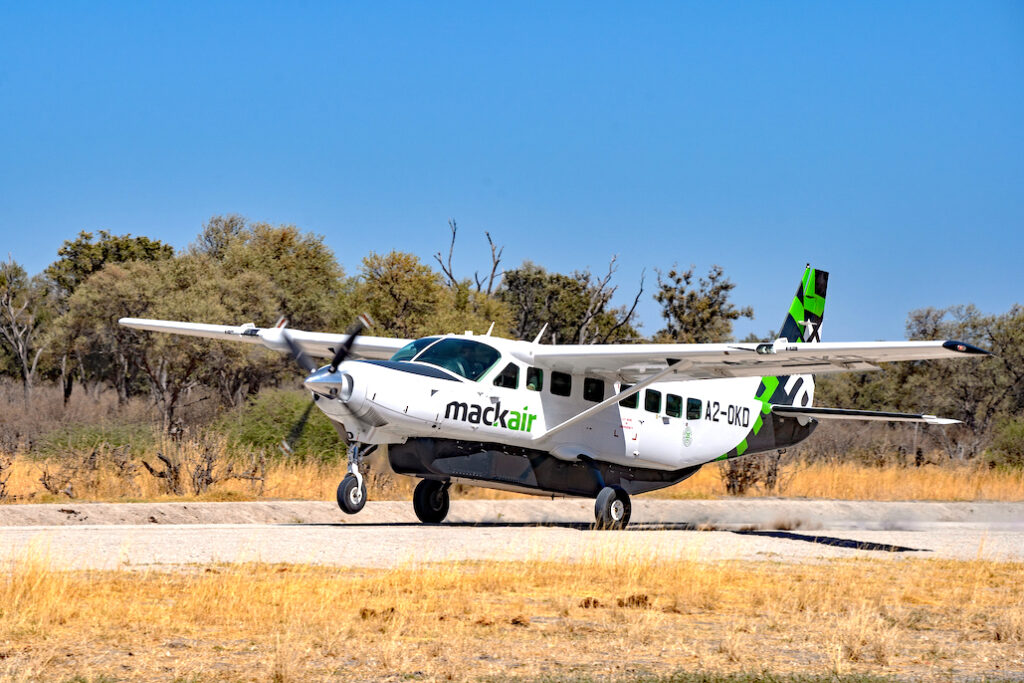
8. LGBTQ Friendly —Tolerance is promoted, and same-sex relationships are legal
This year, Botswana’s High Court unanimously voted to overturn laws that criminalize homosexuality. It was a momentous win for the LGBTQ+ community in Botswana and reflects the values of Botswana’s society.
During the ruling, Judge Michael Leburu admitted that the current laws were “discriminatory” to the LGBTQ community and violated Botswana’s constitution. He argued that overturning them was a matter of “protecting human rights.”
Botswana is actually one of Africa’s most stable democracies. In 2010, they changed their employment act to prevent discrimination against the LGBTQ community. And in 2017, the High Court ruled in favor of a transgender man who sought legal recognition as a male. 
9. Friendly People —Botswanans are some of the nicest people you’ll meet
Botswana might be one of the least densely populated countries in the world, with a population of just over 2 million, but its people are the best. Botswanans are some of the friendliest and most accommodating people that you’ll meet. They take great pride in their country and in giving their best in everything they do.
You’ll be welcomed into Botswana with warm smiles and open hearts. Culturally, singing is incredibly important, so you’ll likely enjoy a song or two during your visit. You might even get to enjoy a few ululations on behalf of Botswanan women, as they show their excitement and happiness.
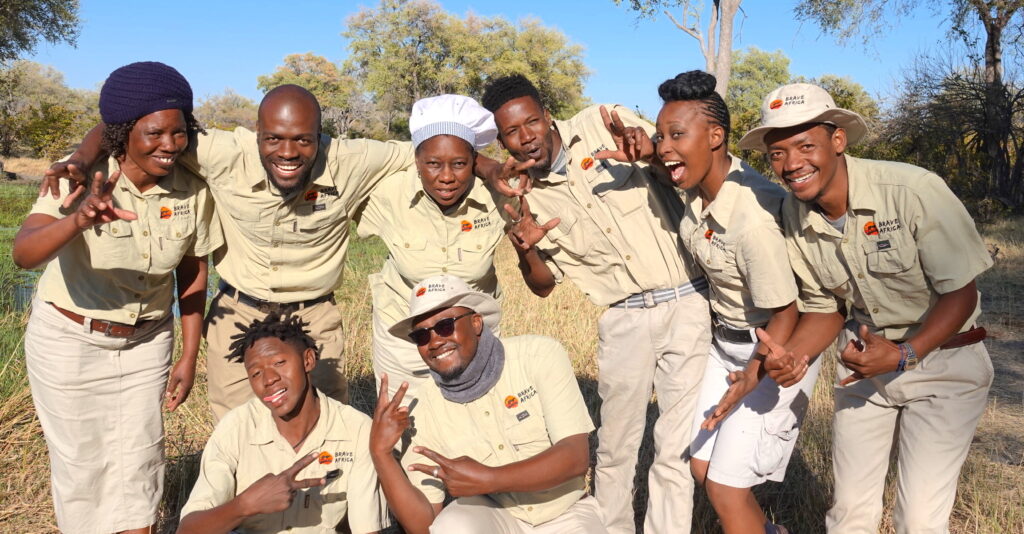
10. Best Safari Location — Botswana is regularly ranked as one of the best safari destinations
Chobe National Park is ranked as the #3 best safari destination in Africa by Fodors. It earns this prestigious title because of its incredibly dense game concentration. The area is “teeming with wildlife year-round,” Fodors writes. They also call Chobe a “stronghold of endangered species such as wild dog, cheetah, and brown hyena.” In particular, they recommend the Savuti Marsh, which we visit on our safaris.
CNN Travel recently put Botswana’s Kalahari Desert on its list of the eight best safari destinations in Africa. They write, “the Kalahari Desert represents Africa at its most brutally wild.” They highlight it as a “land of pure adventure” where you can gain insight into the diversity of Africa. They state, “there’s nothing better than a two-stop safari combining the shimmering pans of the Kalahari with Okavango wetland wilderness.”
Botswana also shows up on CNN Traveler’s “Most Beautiful Countries in the World” list. They talk about the Okavango Delta, calling it a “real-world Eden, where cheetahs, zebras, buffalo, and rhinos roam freely.”
According to Conde Nast Traveler, “Your First Safari Should Be in Botswana.” The article talks about the country’s unique tourism model that focuses on fewer people, but high spenders, so the economy grows, and there’s as little impact on the environment as possible.

Oct 12, 2019 | Brave Africa Safari, Safari Tips
When planning an African adventure, there are a thousand questions you can and should ask yourselves. But we’re here today to talk about a subject that’s often overlooked by safari-goers. Whether it’s your first time on an African adventure or your tenth, before you choose your Africa safari camp or lodge, ask about your safari vehicle.
The Importance of Your Safari Car
Your safari vehicle could make or break your trip. You’ll be in this car day in and day out for hours upon hours at a time. It will be how you get through the thick and wild Bush, and it will be responsible for taking you to the animals.
You might be surprised to learn that every Africa safari camp and lodge uses different vehicles. Sometimes it’s because they want to offer a special experience for their guests, and other times the differences are just about saving costs.
Choosing a company that uses a crappy safari car will leave you feeling vastly disappointed and jealous of every other safari vehicle you see. But if you’ve never been on safari before, how do you know what’s a good safari vehicle and what’s not?
6 Features You Want in Your Safari Vehicle
At Brave Africa, we have top of the line safari vehicles, and we think the experience is well worth it, but don’t take our word for it.
Let’s dive down into the type of experience you want on your African adventure and the kind of safari car you need to make it happen.
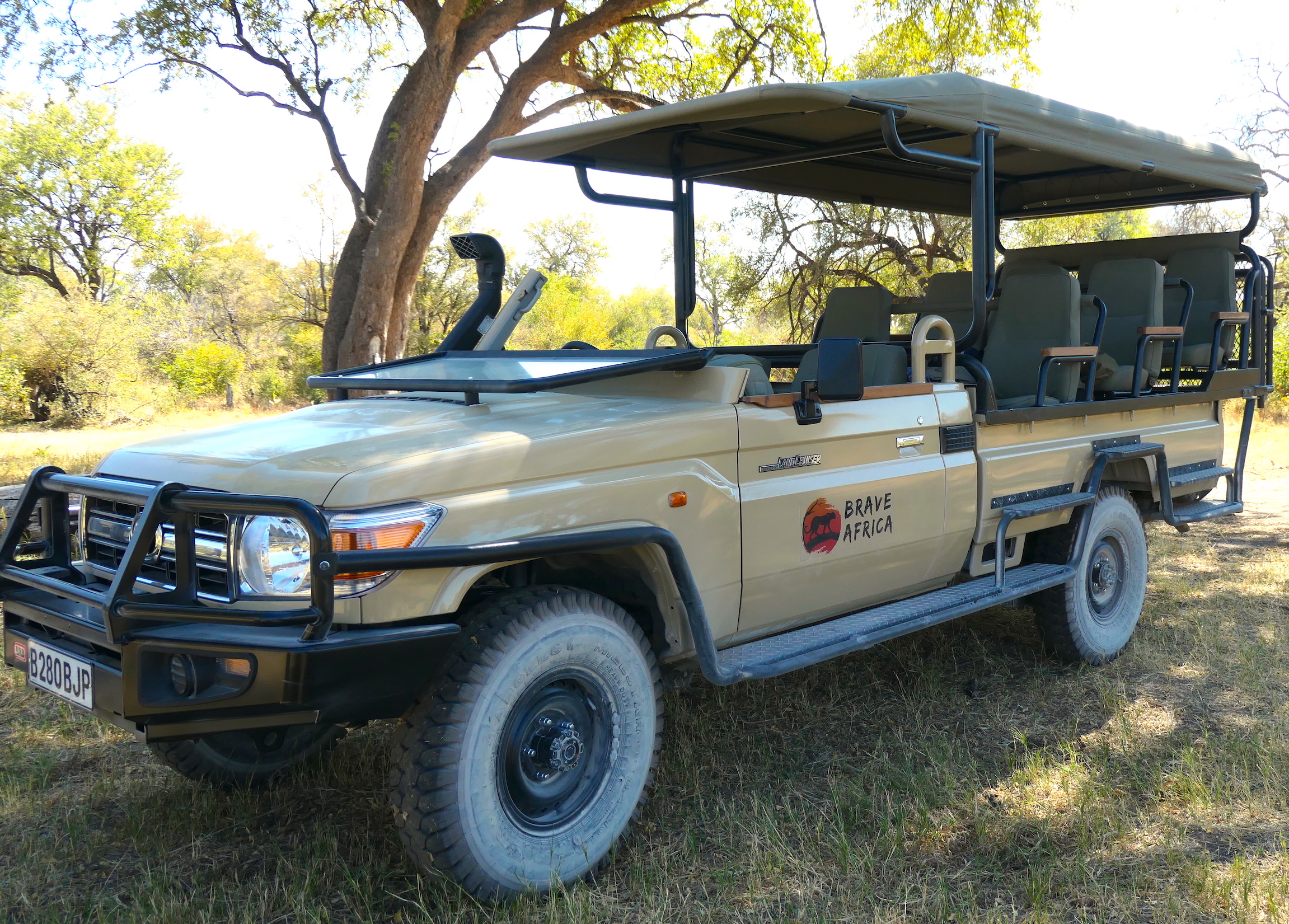
Every Brave Africa safari is custom-built to handle the Botswana Bush. The stadium-style seats in the back are open to the environment but still protected by a canopy from the sun and rain. There’s a snorkel that allows us to go through deep water, custom tires/wheels, a fold-down windshield, USB charging ports, a storage cooler, and more.
1. Toyota Land Cruiser
Twenty-five years ago, the Land Rover was the standard safari vehicle. But as soon as the Toyota Land Cruiser entered the market, it became the new Toyota safari truck, and the game changed forever.
Toyota Land Cruisers are incredible vehicles that can handle the muddiest of conditions without getting stuck. It’s a powerful and dependable vehicle that’s known for exceptional performance, reliability, and durability. It offers a smooth ride even in the toughest of conditions, and it can go for days on a single tank of diesel, of which the safari car has two.
However, an off-the-shelf factory Toyota Land Cruiser isn’t precisely what you’re looking for either. It should be specially modified for safari conditions. These modifications include:
- A snorkel that can handle deep water
- Updated shock and suspension system for a smoother ride
- Increased ground clearance
- Updated wheels and tires specifically designed to handle the African Bush
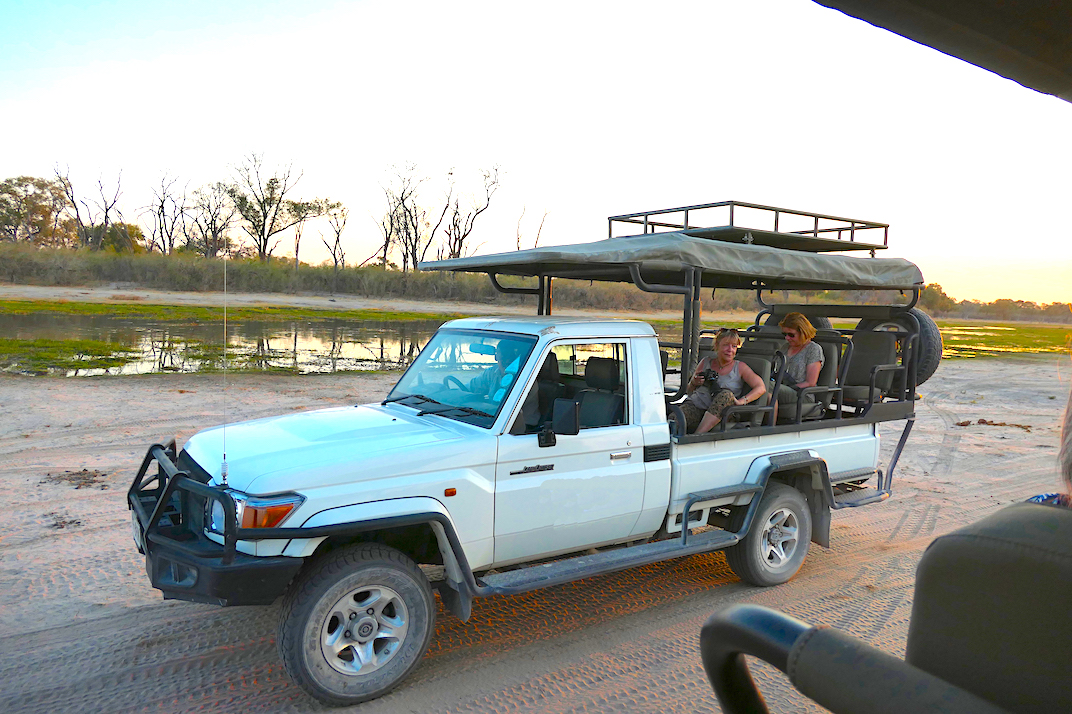
Notice the lack of modifications on this safari vehicle. There is no snorkel, which means deep water will be an issue. There also looks to be little to no modifications when it comes to the wheels/tires, the cab, and more. It’s basically a pickup truck with seating placed on the back.
2. Fully Open Vehicle
If you’ve done any safari research, you’ve probably seen tons of images of different types of vehicles. In Kenya and Tanzania, most safari camps and lodges prefer fully enclosed safari cars where you have to stand up for a clear view of the wildlife without windows.
However, in Southern Africa, including Botswana, you’re mostly going to find safari vehicles with a more open-air approach, but how open it is can drastically change your African adventure.
Open Seating in Your Safari Vehicle
First, let’s talk about your seating area. There are completely open safari vehicles—no windows, doors, or frames blocking your view. Then, some vehicles claim to “protect you from the elements” while at the same time changing how you experience the Bush.
How much access you want to the animals is up to you, but we think the more open, the better. We feel that having something between you and the animals takes away from the magic of your African Adventures. It transforms your experience into something more zoo-like and less “in your face” majesty.
A closed seating area will mean that you’ll deal with less dust, but we think that’s part of the safari experience. We’d rather breathe in a little dust and maybe get wet, but be right there ready and waiting to watch a lion walk by our car or hear an elephant trumpet at us.
However, no matter how open the car is, it’s the seating that matters too. You do not want to be in a car with middle seats. Ask your safari operator how many people they’ll allow per car. We max out at six occupants so that everyone has a window seat, and no one is stuck with a lousy view.
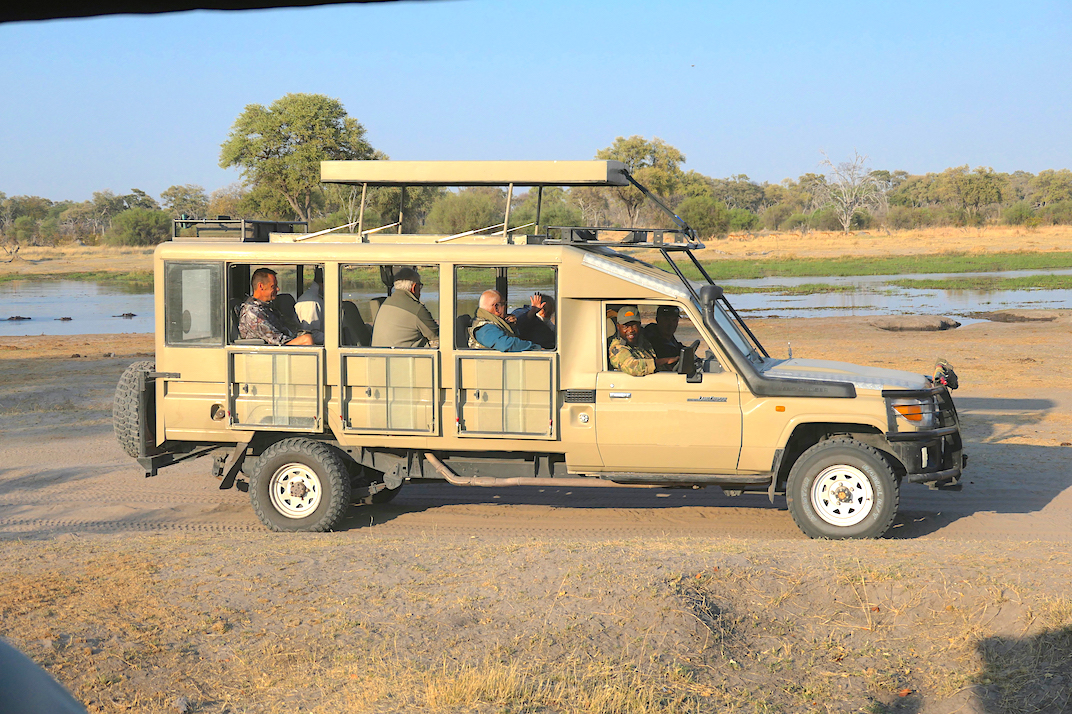
This safari vehicle offers a closed off seating area, which means an obstructed view of the wildlife as well as a hot backseat experience. More likely than not, there’s no air conditioning in the back, and with a closed-off front cab, very little chance for a breeze. That’s tough. And when it comes to birding, this car will not be helpful.
Open Cab Safari Car
Second, let’s talk about the driver’s cab. Even in safari cars where the entire seating area is open to the elements, you might find a situation where the cab is closed. This is definitely something you DO NOT want.
A closed cab means you are closed off from your safari guide. Yes, he or she might still be able to talk to you by leaning out the window, but it’s going to be ten times harder to interact with them, which will greatly detract from your experience.
Your safari guide is essential to your time in the Bush. They’ll explain animal behavior, unique plants, and more. Think of it like being in the car with a live Wikipedia page that can answer all your questions on the spot without the Internet.
Now, imagine that to get to your Wiki page, you had to click ten different buttons to find the answer you wanted. That would get annoying quickly, right? That’s the same with a closed cab. If you don’t have direct and easy access to your guide, you won’t be able to hear what he or she has to tell you throughout your drive, and you’ll lose out on an incredible amount of insight.
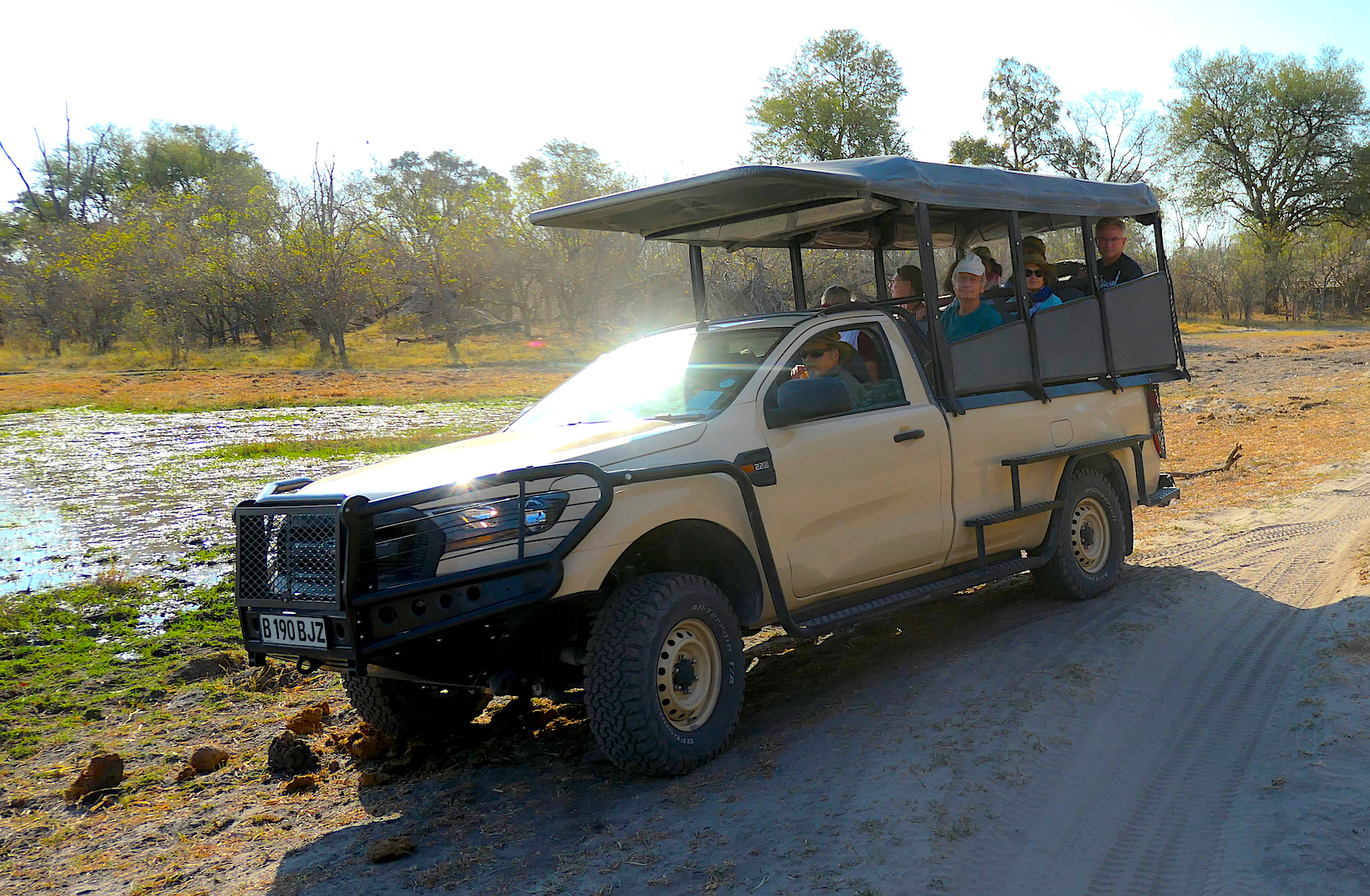
This safari vehicle has a closed cab, which makes it difficult for guests to talk with their guide for a far less personal experience. It also has a very closed in seating area. Those guests in the back row have very limited viewing. Also, notice the middle seat…that’s a lot of guests in one vehicle.
3. Canopy Cover
Now, a fully open vehicle is excellent, except when you don’t have a canopy! Yes, Botswana might be a desert, but that doesn’t mean it won’t ever rain, and when it rains, you want a canopy to keep you from getting soaked. But even when it doesn’t rain, a canopy is fairly essential.
The sun is hot and in Botswana—with an average of 3,300 hours of sunshine every year—and that means you want to be in the shade as much as possible. A fully open cab without even a canopy will mean you have no protection from the elements.
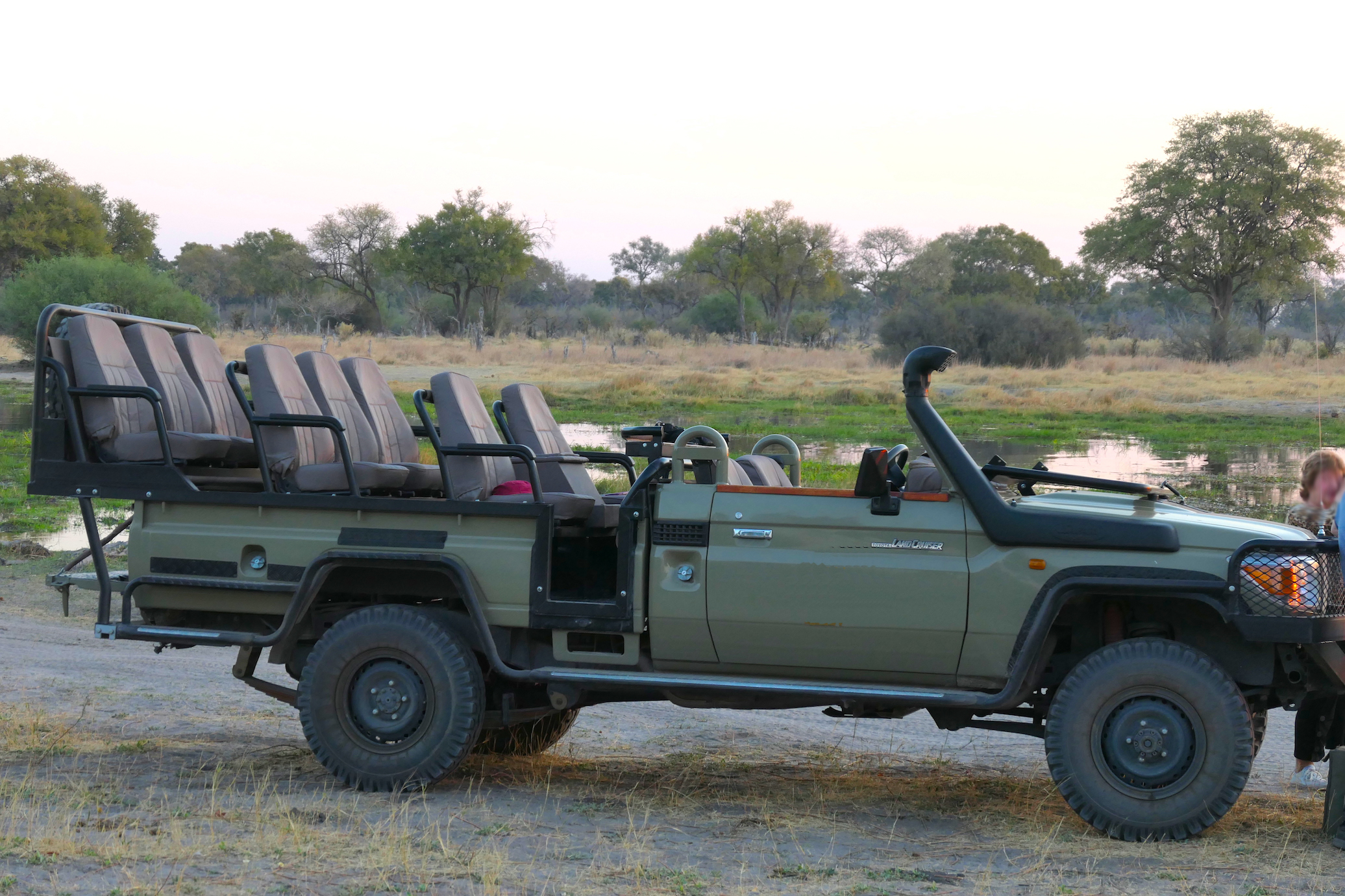
Without a canopy, guests in this vehicle will have no relief from the sun or rain.
4. Safari Car Power Charging
Access to power is critical even in the middle of the Bush. Between our guests’ cameras, phones, and other technology, we know that having the ability to charge your devices is essential to an enjoyable experience. And with 12- to 13-hour game drives, relying on only battery power can be nerve-wracking.
That’s why every Brave Africa safari vehicle offers two USB charging stations at each seat, so you can charge two items at once throughout your daily game drives. You’ll never have to worry about going without power.

Every Brave Africa safari vehicle offers 2 USB ports per seat. Here’s a picture of the four slots for the two front seats.
5. Refrigerator System
When it’s 35 degrees Celsius (95F), it’s way too hot not to have access to ice-cold water, juice, soda, or beer to cool you down in the heat. So, before you choose your African adventure safari, ask the operator if they have a refrigerator system in their safari car.
In the middle of Brave Africa’s first row of passenger seats, we have a large refrigerator that can hold around two dozen cold drinks. This means that no matter how far away from camp you are, you can still enjoy crisp cold drinks on a blistering day.
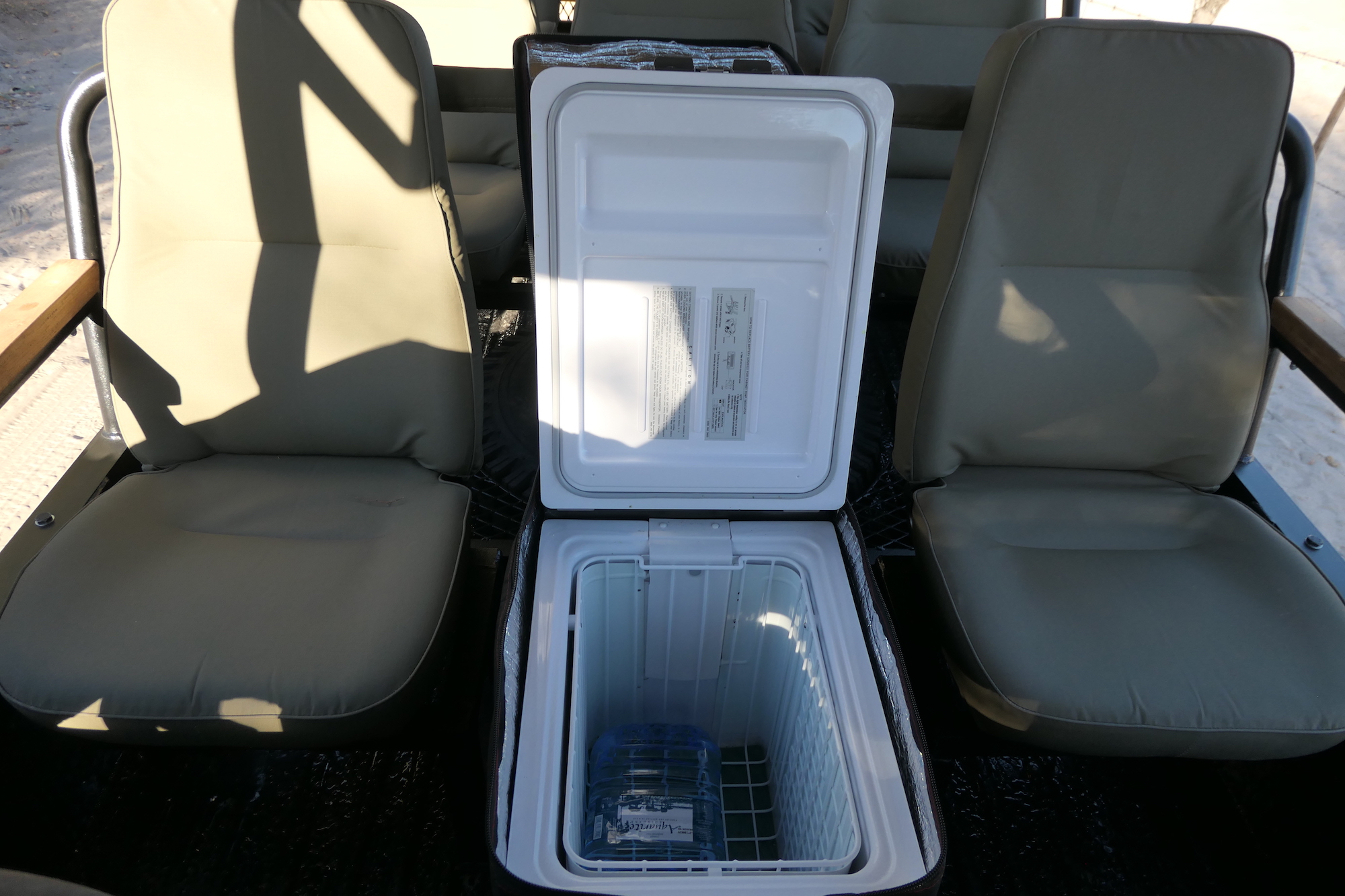
Between the first two seats, we added a cooler for ice-cold drinks and food on every game drive.
6. Storage Options
When you’re on all-day game drives, you need to be able to bring a lot of stuff with you to have a good experience, and that means you need storage space. You need room to store your day bag with your camera, phone, spare jacket, and other personal items. There also needs to be room for snacks, lunch, tables, chairs, and other items you might need on your all-day drive.
At Brave Africa, we max out our vehicle at six guests, so there’s plenty of room to leave your bag. In the back two rows, you can place your stuff in the middle seat. In the front row, you can put your items on top of the refrigerator. There’s also plenty of room to put your bag at your feet as needed.
As for storage for tables and chairs, we’ve built on an extra storage rack on the back of the vehicle. This rack can be folded down or up and used to store guest luggage to and from the airport. We also use it to carry tables and chairs for lunch in the Bush—a requirement for every African adventure.

We built a custom storage rack onto the back of every Brave Africa safari vehicle. This rack can be used to store guest luggage, tables, chairs, and more.

Oct 9, 2019 | Adventure Safari, Behind the Scenes, Brave Africa Safari
On September 1, 2019, Brave Africa embarked on our inaugural safari. It was an incredible nine days in the bush that gave us a little bit of everything. We had a fantastic time at camp, had many once-in-a-lifetime animal sightings, and have memories that will last a lifetime. However, we also had a few things that went wrong, as every startup does.
Here’s our Botswana safari review for our first trip out. (more…)

Sep 28, 2019 | Adventure Safari, Brave Africa Safari, Game Drive, Most Popular Blogs
Out of dozens, if not hundreds, of safaris, what’s the Brave Africa difference? What makes us stand out and why should you choose to join us on your first, second, third, or hundredth safari? It’s all about our all-day safari experience compared to the traditional African safari experience!
The All-Day Safari Experience
Guests go on a Botswana safari for one reason only: to see Africa’s many amazing animals. They want to go home with incredible photos, unbelievable videos, and memories that will last a lifetime.
That’s why, at Brave Africa, our number one priority is to ensure that you have an unforgettable all-day safari experience.
To make that possible, we take our guests on all-day game drives. This increases your possibility of seeing something astonishing by keeping you out of camp and in the Bush as long as possible—after all, you have a 0% possibility of an amazing animal sighting from inside your tent.
12 to 13 hours in the Bush instead of 6 to 7 hours
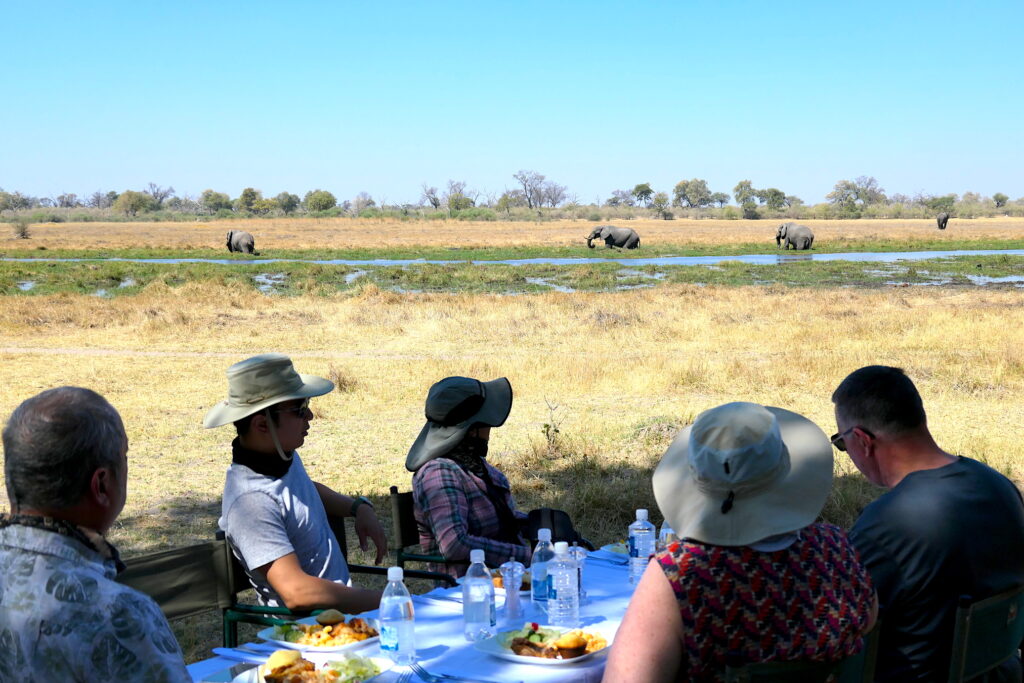
Lunch in the Bush means you get to choose amazing views like this one.
At Brave Africa, you get almost double the time in the Bush as you enjoy on a traditional safari.
On our all-day game drives, you head out of camp at sunrise—between 5:30 am and 6:30 am—and you don’t come back until sunset, or slightly after (6:00 pm – 7:00 pm). In total, you get 12 to 13 hours in the Bush every single day you’re on an all-day safari with Brave Africa.
On a traditional African safari, you have 3 to 4 hours on your morning game drive—from sunrise until around 10:00 am. After that, you’re back at camp for almost 6 hours for lunch and an afternoon nap. Then, you’re finally back out in the Bush at 4:00 pm until sunset for another 2 to 3 hours on a game drive.
That’s just 6 to 7 hours in the Bush with the other 6 hours spent at camp.
Cover more ground instead of being stuck near camp.
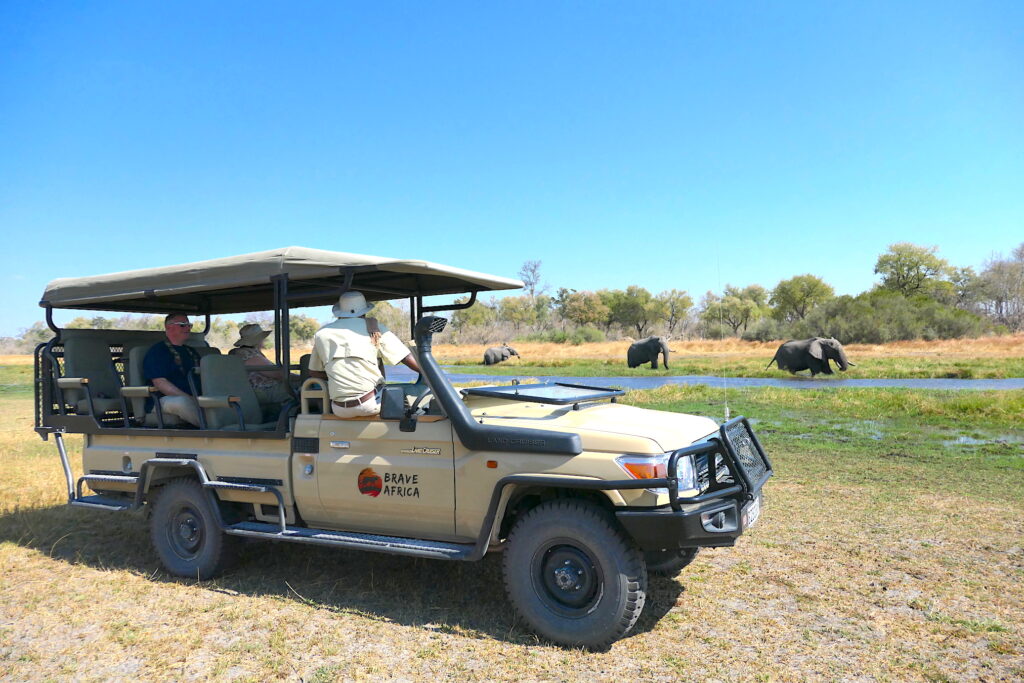
Your Brave Africa safari vehicle can travel almost 6 hours in one direction before having to turn around, which means you can really explore the bush.
Being out on our all-day game drives also means that your Brave Africa car can travel long distances. Since we don’t have to be back at camp until evening, we can really explore the area, following the animals where they go or even just to enjoy a change of scenery.
However, because traditional safaris require you to be back at camp within a few hours, your area of travel is highly limited. You can’t explore too far from your home base or you won’t make it back for lunch.
A pace you control instead of a set schedule.
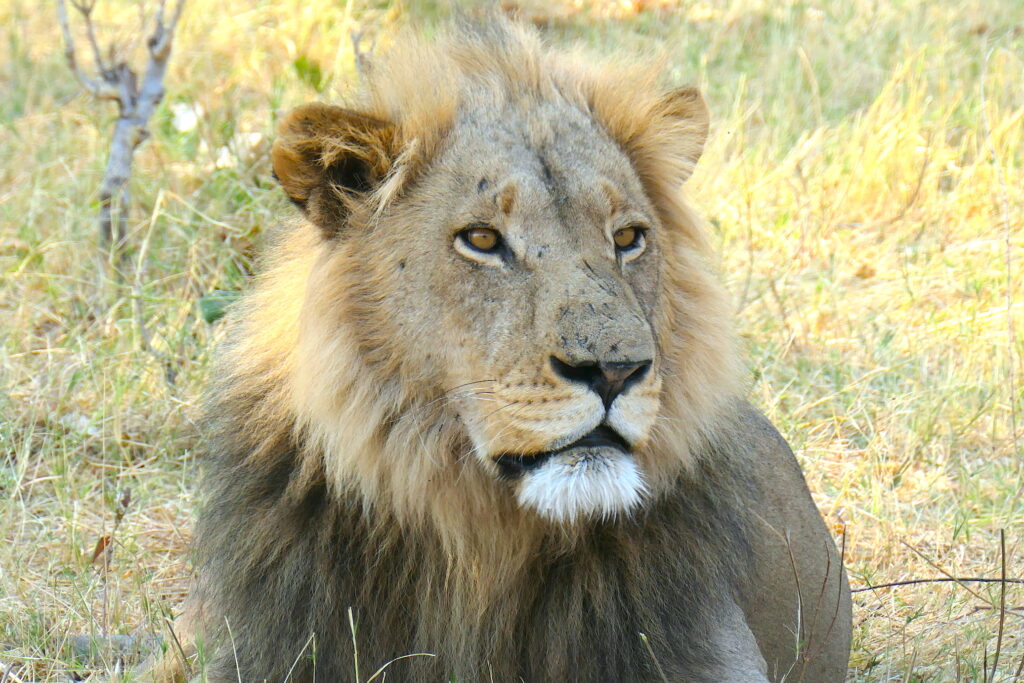
If you are enjoying an incredible sighting of a male lion, you don’t have to leave because you’re on a schedule. You can stay as long as you want.
Twelve to 13 hours in the Bush every day doesn’t mean you never have a chance to breathe or relax. Instead, it means the Bush and the animals help decide your day instead of trying to force nature to conform to our schedule.
So, if your game drive is really packed full of animals, you can put off your rest times until there’s a natural break. However, if the day is slow, you can rest early and give more time to your afternoon. Whenever you’re ready for a break, your guide will find a gorgeous spot in the bush—under some shade—where you can rest, relax, eat, drink, and enjoy the beautiful scenery.
On a traditional African safari, your day is scheduled for you. Yes, if you have an incredible sighting you can stay out longer, but there is always time pressure to get back to camp for lunch. Your schedule is controlled by the camp and not by nature, which can make you feel a little more like you’re in a theme park instead of on a Botswana safari.
Why Do You Want All-Day Game Drives?
So, why are all-day game drives what you want when you go on safari?
- Sometimes during the heat of the day—from 10 am until 3 pm—is the best time to see animals. It was during these hours that on one all-day game drive our guests and team ran into a cheetah hanging out and watching some warthogs.
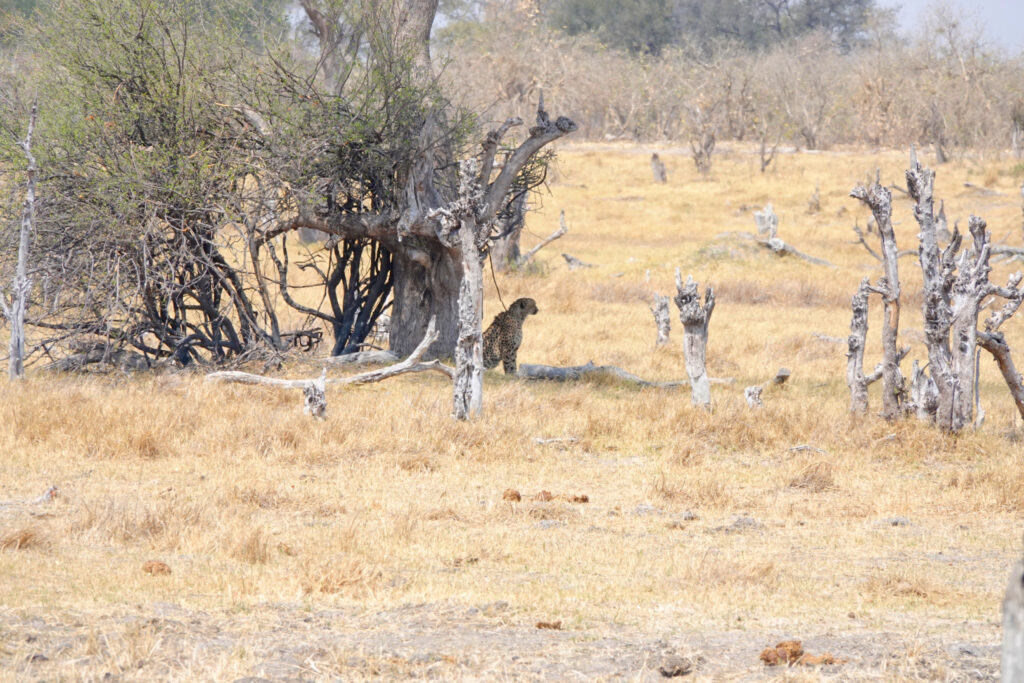
We saw this cheetah around 1 pm during an all-day game drive.
- Botswana is a desert. It’s HOT, especially in the middle of the day. It can easily reach over 40 degrees (C)—over 100 degrees (F)—and that’s hot no matter who you are or where you’re from. Would you rather be roasting in your tent in the middle of the day—few if any camps or lodges in the Bush offer air conditioning in your tent? Or would you rather enjoy the natural air conditioning offered by a moving, open-air vehicle and the chance to see incredible animals?
- A Botswana safari is not cheap. If you’re paying thousands of dollars do you want to pay for an all-day safari or a traditional African safari where you spend half of your time back at camp? You’re basically paying to take a nap instead of paying to spend time with the animals.
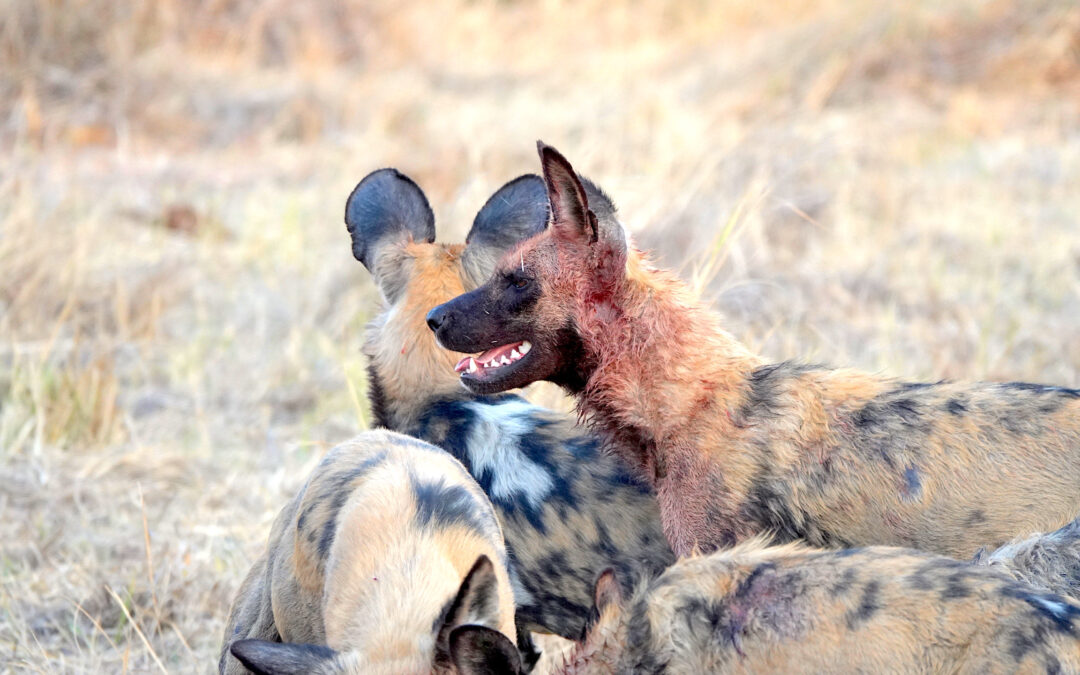
Sep 20, 2019 | Adventure Safari, Animals of Botswana, Brave Africa Safari, Game Drive, Most Popular Blogs
We just completed Brave Africa’s very first full safari, and it was incredible! When you imagine the once-in-a-lifetime experiences you’ll have on a Botswana animal safari, we hit every single one.
It was breathtaking.
If you’re looking for the best animal sightings in Botswana, we had them! (more…)
































